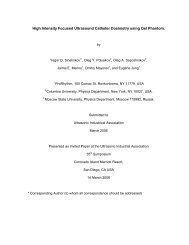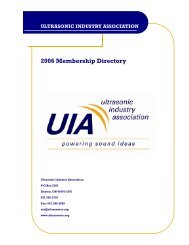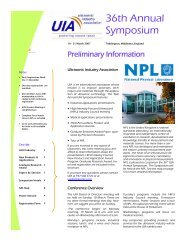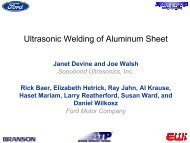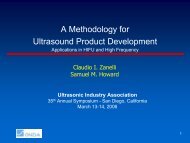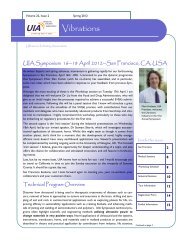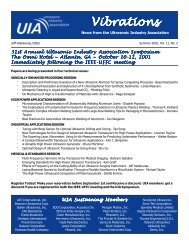The Physical Effects of Bubbles and Cavitation in High Intensity ...
The Physical Effects of Bubbles and Cavitation in High Intensity ...
The Physical Effects of Bubbles and Cavitation in High Intensity ...
Create successful ePaper yourself
Turn your PDF publications into a flip-book with our unique Google optimized e-Paper software.
<strong>The</strong> <strong>Physical</strong> <strong>Effects</strong> <strong>of</strong> <strong>Bubbles</strong> <strong>and</strong><br />
<strong>Cavitation</strong> <strong>in</strong> <strong>High</strong> <strong>Intensity</strong> Focused<br />
Ultrasound<br />
Ronald A. Roy<br />
George Eastman Visit<strong>in</strong>g Pr<strong>of</strong>essor<br />
<strong>The</strong> University <strong>of</strong> Oxford<br />
Boston University, Boston, MA<br />
UIA 36th Annual Symposium<br />
London, UK 21 March, 2007
Presentation Abstract<br />
<strong>The</strong> application <strong>of</strong> ultrasound to tissue at therapeutic levels can, <strong>in</strong> some cases,<br />
result <strong>in</strong> bubble formation. <strong>The</strong>se bubbles can promote mechanical disruption,<br />
accelerate tissue heat<strong>in</strong>g, <strong>and</strong> contribute to the formation <strong>of</strong> irregularly shaped<br />
lesions. <strong>The</strong> relevant mechanical <strong>and</strong> thermal effects depend critically on several<br />
factors, such as temporal peak <strong>and</strong> temporal average acoustic <strong>in</strong>tensity, the<br />
duration <strong>of</strong> cw <strong>in</strong>sonation, the duration <strong>and</strong> duty cycle <strong>of</strong> pulse <strong>in</strong>sonation, the<br />
presence <strong>of</strong> cavitation nuclei, tissue temperature, <strong>and</strong> the tissue acoustic,<br />
rheological, <strong>and</strong> thermal properties. We will present a brief primer on the relevant<br />
bubble dynamics followed by a summary description <strong>of</strong> what physical effects<br />
matter, when <strong>and</strong> why. Implications for HIFU treatment monitor<strong>in</strong>g through the<br />
active <strong>and</strong> passive bubble detection are discussed. [Work supported by the Dept.<br />
<strong>of</strong> the Army (award No. DAMD17-02-2-0014) <strong>and</strong> the Center for Subsurface<br />
Sens<strong>in</strong>g <strong>and</strong> Imag<strong>in</strong>g Systems (NSF ERC Award No. EEC-9986821).]<br />
2
Medical Ultrasonics <strong>in</strong> a Nutshell<br />
<br />
Diagnostic Procedures<br />
<br />
Imag<strong>in</strong>g, blood flow, multi-mode, molecular, functional<br />
<br />
<strong>The</strong>rapeutic Procedures<br />
<br />
<br />
<br />
Tissue heal<strong>in</strong>g/destruction<br />
Hemostasis & thrombolysis<br />
Drug delivery <strong>and</strong> much more<br />
<br />
Process Control<br />
<br />
Mix<strong>in</strong>g, clean<strong>in</strong>g, lysis, sonoporation, sonochemistry<br />
<br />
<strong>The</strong>rmal & Mechanical <strong>Effects</strong><br />
3
<strong>Physical</strong> Interactions<br />
<br />
Sound scatter<strong>in</strong>g from <strong>in</strong>terfaces <strong>and</strong><br />
microstructure<br />
<strong>The</strong> basis for ultrasound imag<strong>in</strong>g<br />
<br />
Sound absorption<br />
Tissue heat<strong>in</strong>g<br />
<br />
Momentum transfer<br />
Convective stream<strong>in</strong>g & radiation stress<br />
<br />
Mechanical Stress<br />
Tissue rupture -- acoustic cavitation<br />
4
A Prom<strong>in</strong>ent Role for Microbubbles!<br />
<br />
<strong>Bubbles</strong> promote sound scatter<strong>in</strong>g<br />
<br />
Ultrasound contrast agents<br />
<br />
<strong>Bubbles</strong> promote tissue heat<strong>in</strong>g<br />
<br />
<strong>Bubbles</strong> promote tissue disruption<br />
<br />
<br />
Rupture, shock waves,<br />
Collapse jets, microstream<strong>in</strong>g<br />
<br />
<strong>Bubbles</strong> promote drug delivery<br />
<br />
Target<strong>in</strong>g, sonoporation, sonochemistry<br />
<br />
Many other effects<br />
<br />
Opto-acoustics, , laser ablation, vessel occlusion…<br />
5
A Primer on Bubble Acoustics<br />
Nonl<strong>in</strong>ear Response <strong>of</strong> a s<strong>in</strong>gle bubble<br />
Consider force balance across a bubble wall<br />
Internal: gas pressure vapor pressure<br />
External: hydrostatic pressure, surface tension<br />
Dynamics: acoustic stress, viscous stress<br />
Rayleigh Plesset Equation<br />
1-D radial motion, Newtonian <strong>in</strong>compressible fluid<br />
#<br />
" o % R˙ R ˙ + 3 $ 2 ˙<br />
R 2<br />
& ,#<br />
( = % P<br />
' o<br />
) P v<br />
+ 2* &#<br />
.<br />
%<br />
- $ ' $<br />
R o<br />
( R o<br />
R<br />
3+<br />
&<br />
(<br />
'<br />
/<br />
+ P v<br />
0<br />
1 ) 2* R ) 4µ R ˙<br />
R<br />
) ( P o<br />
+ P a<br />
s<strong>in</strong>2t)<br />
Inertial Terms<br />
Total Internal Pressure<br />
Total External Pressure<br />
Keller Miksis Equation<br />
Accounts for the compressibility <strong>of</strong> the liquid<br />
6
Acoustic <strong>Cavitation</strong><br />
A Recipe…<br />
Start with a preferential site for liquid rupture<br />
<br />
<strong>Physical</strong> impurity, preexist<strong>in</strong>g gas cavity<br />
Apply an acoustic stress strong enough to<br />
overcome…<br />
<br />
Surface tension, <strong>in</strong>ertia, viscous drag<br />
Bubble responds <strong>in</strong> accordance with nonl<strong>in</strong>ear<br />
equation <strong>of</strong> motion<br />
Two Classes <strong>of</strong> Bubble Response…<br />
7
Geneology <strong>of</strong> <strong>Cavitation</strong><br />
Stable <strong>Cavitation</strong><br />
Drive bubble at low-moderate forc<strong>in</strong>g pressures<br />
Repetitive pulsations about an equilibrium radius<br />
Motion dom<strong>in</strong>ated by the compressibility <strong>of</strong> the gas<br />
Pressures <strong>of</strong> order 1-5 ATM (depend<strong>in</strong>g on frequency <strong>and</strong><br />
bubble size)<br />
Larger bubbles<br />
Rectified diffusion<br />
Acoustic emissions<br />
Harmonic<br />
Subharmonic<br />
Noise diagnostics<br />
F = 1 MHz<br />
Res ≈ 4-5 µm<br />
R 0 = 30 µm<br />
R Res<br />
8
<strong>Physical</strong> <strong>Effects</strong><br />
Stable <strong>Cavitation</strong><br />
Microstream<strong>in</strong>g <strong>in</strong> the fluid media<br />
Promotes mix<strong>in</strong>g (chemical reactions, drug delivery, etc.)<br />
Promotes clean<strong>in</strong>g<br />
Promotes cell lysis<br />
<strong>Cavitation</strong> microstream<strong>in</strong>g<br />
<strong>in</strong> Elodea<br />
Leaf<br />
Courtesy Ed<br />
Carstensen, Doug<br />
Miller <strong>and</strong> Wes Nyborg<br />
9
<strong>Physical</strong> <strong>Effects</strong>: Inertial <strong>Cavitation</strong><br />
Sonolum<strong>in</strong>escence<br />
“light from sound”<br />
Inertial collapses <strong>of</strong><br />
acoustically forced<br />
bubbles <strong>in</strong> liquid<br />
Generic SL Cycle:<br />
Isothermal expansion<br />
Rapid adiabatic<br />
collapse<br />
Chemical dissociation<br />
Bubble Size<br />
• • • • •<br />
Acoustic Pressure<br />
Bubble Radius<br />
F = 20 kHz<br />
Res = 160 µm<br />
R 0 = 0.1 µm<br />
R Res<br />
Light <strong>Intensity</strong><br />
0 Time (µsec) 50<br />
11
<strong>Physical</strong> <strong>Effects</strong><br />
Inertial <strong>Cavitation</strong><br />
Sonolum<strong>in</strong>escence <strong>in</strong> water exposed to<br />
a 20 kHz ultrasonic horn<br />
Courtesy Lawrence Crum, Univ. . <strong>of</strong> Wash<strong>in</strong>gton<br />
12
<strong>Physical</strong> <strong>Effects</strong><br />
Inertial <strong>Cavitation</strong><br />
Extensive<br />
Microstream<strong>in</strong>g<br />
Shear<strong>in</strong>g flows <strong>and</strong> tear<br />
apart tissues<br />
Collapse microjets<br />
Radiated shock waves<br />
Extreme conditions<br />
Inside the collaps<strong>in</strong>g<br />
bubble<br />
Converts acoustical<br />
energy to concentrated<br />
mechanical <strong>and</strong> thermal<br />
energy<br />
…<strong>The</strong>rmal Energy?<br />
13
<strong>Physical</strong> <strong>Effects</strong><br />
Inertial <strong>Cavitation</strong><br />
Collapse Microjets<br />
Hydrodynamic<br />
<strong>Cavitation</strong><br />
Acoustic<br />
<strong>Cavitation</strong><br />
Courtesy Lawrence Crum, Univ. . <strong>of</strong> Wash<strong>in</strong>gton<br />
14
<strong>Physical</strong> <strong>Effects</strong><br />
Inertial <strong>Cavitation</strong><br />
Collapse Microjets<br />
A vapor cavity <strong>in</strong><br />
glycer<strong>in</strong>e<br />
Courtesy Lawrence Crum, Univ. . <strong>of</strong> Wash<strong>in</strong>gton<br />
15
<strong>Physical</strong> <strong>Effects</strong><br />
Collapse Jets<br />
Extracorporeal Shock Wave Lithotripsy<br />
Jett<strong>in</strong>g from a cavitation cloud!<br />
One <strong>of</strong> several physical mechanisms for<br />
kidney stone destruction<br />
Courtesy Mike Bailey, Univ. . <strong>of</strong> Wash<strong>in</strong>gton & Rob<strong>in</strong> Clevel<strong>and</strong>, Boston Univ.<br />
16
<strong>Physical</strong> <strong>Effects</strong><br />
Collapse Jets<br />
<strong>Cavitation</strong><br />
Occurs Here<br />
Courtesy Mike Bailey, Univ. . <strong>of</strong> Wash<strong>in</strong>gton & Rob<strong>in</strong> Clevel<strong>and</strong>, Boston Univ.<br />
17
Geneology <strong>of</strong> <strong>Cavitation</strong><br />
Cloud Collapse Dynamics<br />
Extracorporeal Shock Wave Lithotripsy<br />
Erod<strong>in</strong>g an “artificial” kidney stone<br />
50 SWs<br />
Courtesy Mike Bailey, Univ. . <strong>of</strong> Wash<strong>in</strong>gton & Rob<strong>in</strong> Clevel<strong>and</strong>, Boston Univ.<br />
18
<strong>Physical</strong> <strong>Effects</strong><br />
Where to go from here..<br />
Microstream<strong>in</strong>g<br />
Th<strong>in</strong>k, th<strong>in</strong>k, th<strong>in</strong>k<br />
Collapse microjets<br />
Radiated shock waves<br />
Extreme conditions<br />
Other effects<br />
Too little time!<br />
Mechanism for convert<strong>in</strong>g acoustical energy to highly<br />
concentrated mechanical <strong>and</strong> thermal energy<br />
…<strong>The</strong>rmal Energy???<br />
19
Focused Ultrasound Surgery<br />
Tissue Heat<strong>in</strong>g by HIFU<br />
Liver<br />
Ultrasound<br />
Source<br />
Sk<strong>in</strong><br />
Tumor<br />
20
Geneology <strong>of</strong> <strong>Cavitation</strong><br />
Inertial <strong>Cavitation</strong><br />
Drive bubble at higher forc<strong>in</strong>g pressures<br />
Unstable growth followed by violent collapse<br />
Motion dom<strong>in</strong>ated by the <strong>in</strong>ertial <strong>of</strong> the liquid<br />
Pressures > 10-15 ATM (depend<strong>in</strong>g on frequency)<br />
Subresonant bubbles<br />
Acoustic emissions<br />
Broadb<strong>and</strong><br />
Noise Diagnostics<br />
F = 1 MHz<br />
Res ≈ 4-5 µm<br />
R 0 = 0.1 µm<br />
R Res<br />
10
Focused Ultrasound Surgery<br />
Tissue Heat<strong>in</strong>g by HIFU<br />
US Beam<br />
Direction<br />
Courtesy Gail ter Haar<br />
Institute for Cancer<br />
Research<br />
21
Cancer<br />
<br />
Focused Ultrasound Surgery<br />
Tissue Heat<strong>in</strong>g by HIFU<br />
Liver, kidney, prostate, breast, bra<strong>in</strong>, sk<strong>in</strong>…<br />
Non Cancer<br />
<br />
Uter<strong>in</strong>e fibroids, BPH, opthalmology…<br />
Trauma Care<br />
<br />
Acoustic hemostasis<br />
Transcutaneous<br />
Intraoperative<br />
Cl<strong>in</strong>ical Trials<br />
<br />
<br />
<br />
<br />
<br />
Columbia University<br />
Univ. . <strong>of</strong> Wash<strong>in</strong>gton<br />
Oxford University<br />
Multiple sites <strong>in</strong> Ch<strong>in</strong>a<br />
Others…<br />
HAIFU ‘JC-Tumor <strong>The</strong>rapy System’<br />
22
Focused Ultrasound Surgery<br />
Dependence on HIFU Pressure Amplitude<br />
45<br />
Temperature rise (˚C)<br />
40<br />
35<br />
30<br />
25<br />
20<br />
15<br />
10<br />
1.4 MPa<br />
1.3 MPa<br />
1.2 MPa<br />
1.1 MPa<br />
ΔP P = 0.1 MPa<br />
5<br />
0<br />
0 1 2 3 4 5<br />
Exposure Time (sec)<br />
Threshold suggestive <strong>of</strong> the onset <strong>of</strong> cavitation<br />
23
Focused Ultrasound Surgery<br />
Dependence on HIFU Pressure Amplitude<br />
40<br />
saturation<br />
Temperature rise (˚C)<br />
35<br />
30<br />
25<br />
20<br />
15<br />
10<br />
enhancement<br />
l<strong>in</strong>ear<br />
Shield<strong>in</strong>g???<br />
TC1 (0.5mm)<br />
BHTE<br />
5<br />
0<br />
0 0.5 1 1.5 2 2.5<br />
Pressure Amplitude (MPa)<br />
Phantom: Graphite & agar mix Frequency = 1 MHz Duration = 1 second<br />
24
Sens<strong>in</strong>g Accelerated Heat<strong>in</strong>g with Noise<br />
Good correlation<br />
between onset <strong>of</strong><br />
enhanced heat<strong>in</strong>g &<br />
onset <strong>of</strong> broadb<strong>and</strong><br />
acoustic emissions<br />
Inertial <strong>Cavitation</strong><br />
Matters Most<br />
Temperature Change (°C)<br />
30<br />
20<br />
10<br />
0<br />
30<br />
20<br />
10<br />
0<br />
30<br />
1.9 MPa<br />
1.8 MPa<br />
1.65 MPa<br />
1<br />
0.5<br />
0<br />
1<br />
0.5<br />
0<br />
1<br />
PCD Output (Arb.)<br />
20<br />
10<br />
0.5<br />
0<br />
0<br />
0 1 2 3 4 5<br />
Time (s)<br />
25
Model<strong>in</strong>g Bubble Enhanced Heat<strong>in</strong>g<br />
"C #T<br />
Conduction<br />
67 8 SourceTerms<br />
64 748<br />
#t = K$2 T + q us<br />
+ q bubbles<br />
q bubbles<br />
= q vis<br />
+ q rad<br />
q us<br />
= 2"<br />
# 2 $c<br />
&%p)<br />
( +<br />
'%t<br />
*<br />
Computed from<br />
FDTD solution to<br />
Westervelt Eq.<br />
2<br />
!<br />
Related to product <strong>of</strong><br />
viscous force <strong>and</strong> bubble<br />
wall velocity<br />
-------------<br />
larger bubbles<br />
higher viscosities<br />
-------------<br />
Stable <strong>Cavitation</strong><br />
is Implicated<br />
<strong>The</strong> absorption <strong>of</strong> broad-<br />
b<strong>and</strong> acoustic emissions<br />
-------------<br />
smaller bubbles<br />
low viscosities<br />
-------------<br />
Inertial <strong>Cavitation</strong><br />
is Implicated<br />
26
Can We Control -- or at least monitor -- this?<br />
<br />
Measured vs. . predicted temperature rise with bubbles present<br />
Measured ∆T T exceeds visco-thermal predictions<br />
Deviation always occur when there is broad b<strong>and</strong> noise<br />
Use <strong>of</strong> noise diagnostics to monitor bubble enhanced heat<strong>in</strong>g<br />
27
Reduction <strong>in</strong> PCD Emission With Time?<br />
<br />
For sufficiently high pressures, PCD focal emissions always<br />
decrease with time<br />
<br />
<br />
<br />
Reduced bubble-assisted heat<strong>in</strong>g rates<br />
Suggestive <strong>of</strong> focal shield<strong>in</strong>g?<br />
Inhibit cavitation field growth while still driv<strong>in</strong>g <strong>in</strong>ertially<br />
3.9 MPa Cont<strong>in</strong>uous Wave (CW)<br />
28
A Simple <strong>Cavitation</strong> Controller?<br />
<br />
100-cycle burst at 2.2 kHz PRF (20% duty cycle)<br />
Boil<strong>in</strong>g<br />
<br />
Puls<strong>in</strong>g the HIFU field serves top stabilize the PCD signal<br />
<br />
<br />
Measurements <strong>in</strong>dicate a lower focal temperature rise<br />
Is this effect due only to prefocal heat<strong>in</strong>g, or is temperature<br />
implicated as well?<br />
29
What Happens if the Tissue Gets Too<br />
Hot Too Quickly?<br />
Lesion formation <strong>in</strong> a gel<br />
<br />
<br />
LHS: side light<strong>in</strong>g<br />
RHS: back light<strong>in</strong>g<br />
3.5 MHz, 14 kW/cm 2 , 30 sec exposure<br />
Two separate runs <strong>in</strong> a low<br />
absorb<strong>in</strong>g phantom<br />
Boil<strong>in</strong>g leads to the formation <strong>of</strong> a<br />
malformed tadpole” lesion<br />
Inertial cavitation precedes boil<strong>in</strong>g,<br />
but the progression is extremely<br />
rapid (10’s s <strong>of</strong> msec)<br />
Khokhlova et al., J. Acoust Soc. Am.<br />
119, , 834-848, 2006<br />
30
What Happens if the Tissue Gets Too<br />
Hot Too Quickly?<br />
31
<strong>Bubbles</strong> <strong>and</strong> HIFU Lesion Formation<br />
<br />
<br />
<br />
<strong>Bubbles</strong> alter the acoustic properties <strong>of</strong> the medium.<br />
Subresonant size -- employ an effective medium approximation:<br />
<br />
Sound speed depression <strong>and</strong> enhanced e<br />
attenuation<br />
Shield<strong>in</strong>g beyond the focus <strong>and</strong> backscattered energy pre-focally<br />
<br />
<br />
Shields the “target” from <strong>in</strong>cident energy<br />
Causes the lesion to migrate towards the transducer<br />
<br />
<br />
Greater energy = more heat<strong>in</strong>g<br />
Problematic when form<strong>in</strong>g larger lesions<br />
As the tissue heats, bubble collapse arrested by vapor pressure<br />
<br />
Inertial cavitation “shuts down” <strong>and</strong> boil<strong>in</strong>g takes over<br />
Is sens<strong>in</strong>g & controll<strong>in</strong>g <strong>in</strong>ertial cavitation a moot po<strong>in</strong>t?<br />
32
Not Necessarily<br />
<br />
<br />
<br />
<br />
So long as you avoid boil<strong>in</strong>g temperatures, controlled <strong>in</strong>ertial<br />
cavitation can still <strong>of</strong>fer therapeutic value<br />
“Gentler” heat<strong>in</strong>g <strong>and</strong>/or non-thermal effects may be desirable<br />
<br />
<br />
Heat<strong>in</strong>g <strong>of</strong> sensitive regions<br />
Thrombolysis, , drug delivery, non-thermal tissue disruption<br />
Real-time feedback for tun<strong>in</strong>g the bubble field<br />
<br />
Control via duty cycle, pressure schedule, multiple frequencies<br />
Why isn’t t this currently be done <strong>in</strong> vivo?<br />
<br />
<br />
<strong>The</strong>re are no cavitation nuclei <strong>in</strong> tissue!<br />
Nuclei are essential <strong>and</strong> may need to be <strong>in</strong>troduced externally<br />
(contrast agents, etc.)<br />
33
In Clos<strong>in</strong>g…<br />
<br />
<br />
<br />
<br />
<strong>Bubbles</strong> play a variety <strong>of</strong> roles <strong>in</strong> a wide range <strong>of</strong> diagnostic,<br />
therapeutic <strong>and</strong> process ultrasound procedures<br />
<strong>The</strong> list is far longer that the material just presented!<br />
“Bubble response physics” is diverse <strong>and</strong> can be highly<br />
nonl<strong>in</strong>ear<br />
L<strong>in</strong>ear: scatter<strong>in</strong>g, absorption, dispersion<br />
Nonl<strong>in</strong>ear: stream<strong>in</strong>g, jett<strong>in</strong>g, shocks, energy concentration, extreme<br />
conditions upon <strong>in</strong>ertial collapse<br />
For years cavitation was someth<strong>in</strong>g to avoid<br />
Control via duty cycle, pressure schedule, multiple frequencies<br />
<strong>Cavitation</strong> is now be<strong>in</strong>g used to promote both diagnostic <strong>and</strong><br />
therapeutic effects<br />
For HIFU, pre-exist<strong>in</strong>g cavitation nuclei are essential<br />
34
I Thank…<br />
YOU, FOR YOUR KIND ATTENTION…<br />
MY SPONSORS FOR THEIR GENEROSITY…<br />
<br />
<strong>The</strong> Center for Subsurface Sens<strong>in</strong>g <strong>and</strong> Imag<strong>in</strong>g Systems via<br />
NSF:ERC EEC-9986821<br />
<strong>The</strong> US Army Award No. DAMD 17-02-2-0014<br />
AND ESPECIALLY MY COLLEAGUES AND STUDENTS…<br />
<br />
<br />
<br />
R. Glynn Holt, Rob<strong>in</strong> O. Clevel<strong>and</strong>, Constant<strong>in</strong> Coussios,<br />
Charlie Thomas<br />
Caleb Farny, Tianm<strong>in</strong>g Wu, X<strong>in</strong>mai Yang, J<strong>in</strong>lan Huang,<br />
Patrick Edson<br />
<strong>The</strong> National Center for <strong>Physical</strong> Acoustics, <strong>The</strong> Center for<br />
Medical & Industrial Ultrasound, <strong>The</strong> Institute for Cancer<br />
Research<br />
35



